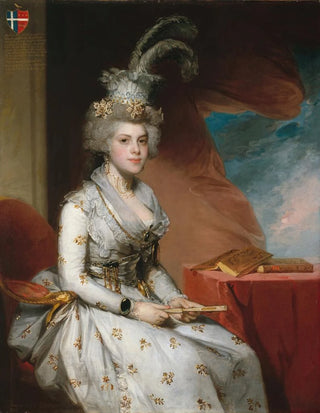Art print | Matilda Stoughton de Jaudenès - Gilbert Stuart


View from behind

Frame (optional)
Gilbert Stuart's "Matilda Stoughton de Jaudenès" art print is a true masterpiece that embodies the very essence of early 19th-century American portraiture. Capturing the elegance and sophistication of a bygone era, this painting stands out for its striking realism and meticulous attention to detail. The depiction of Matilda Stoughton, a woman of high society of the time, evokes not only physical beauty but also the depth of personality. Through this art print, Stuart manages to transcend mere painting to offer a glimpse into the life and customs of an evolving elite.
Style and uniqueness of the art print
Gilbert Stuart's style is characterized by refined painting techniques, where light and shadow combine to bring the faces he immortalizes to life. In "Matilda Stoughton de Jaudenès," the softness of his model's features is accentuated by a delicate color palette, creating an intimate and warm atmosphere. Stuart excels in capturing textures, whether it is the sumptuous fabrics of the sitter's dress or the shine of her hair. Each brushstroke demonstrates exceptional technical mastery, allowing the viewer to feel an almost tangible connection with the subject. This art print does not merely depict a woman; it tells a story—of a time when portrait art reflected the aspirations and values of a society in full transformation.
The artist and his influence
Gilbert Stuart, born in 1755, is often regarded as one of the greatest American portraitists of his era. Trained in Europe, he mastered integrating influences from European masters while developing a style uniquely his own. His work not only marked his time but continues to influence contemporary artists. Stuart is best known for his portraits of iconic political figures, notably George Washington, but it is through works like "Matilda Stoughton de Jaudenès" that he captured daily life and the spirit of his time. His innovative approach to portraiture paved the way for a new way of considering the subject, going beyond simple representation to explore the psychology and identity of his models.

Matte finish

View from behind

Frame (optional)
Gilbert Stuart's "Matilda Stoughton de Jaudenès" art print is a true masterpiece that embodies the very essence of early 19th-century American portraiture. Capturing the elegance and sophistication of a bygone era, this painting stands out for its striking realism and meticulous attention to detail. The depiction of Matilda Stoughton, a woman of high society of the time, evokes not only physical beauty but also the depth of personality. Through this art print, Stuart manages to transcend mere painting to offer a glimpse into the life and customs of an evolving elite.
Style and uniqueness of the art print
Gilbert Stuart's style is characterized by refined painting techniques, where light and shadow combine to bring the faces he immortalizes to life. In "Matilda Stoughton de Jaudenès," the softness of his model's features is accentuated by a delicate color palette, creating an intimate and warm atmosphere. Stuart excels in capturing textures, whether it is the sumptuous fabrics of the sitter's dress or the shine of her hair. Each brushstroke demonstrates exceptional technical mastery, allowing the viewer to feel an almost tangible connection with the subject. This art print does not merely depict a woman; it tells a story—of a time when portrait art reflected the aspirations and values of a society in full transformation.
The artist and his influence
Gilbert Stuart, born in 1755, is often regarded as one of the greatest American portraitists of his era. Trained in Europe, he mastered integrating influences from European masters while developing a style uniquely his own. His work not only marked his time but continues to influence contemporary artists. Stuart is best known for his portraits of iconic political figures, notably George Washington, but it is through works like "Matilda Stoughton de Jaudenès" that he captured daily life and the spirit of his time. His innovative approach to portraiture paved the way for a new way of considering the subject, going beyond simple representation to explore the psychology and identity of his models.






